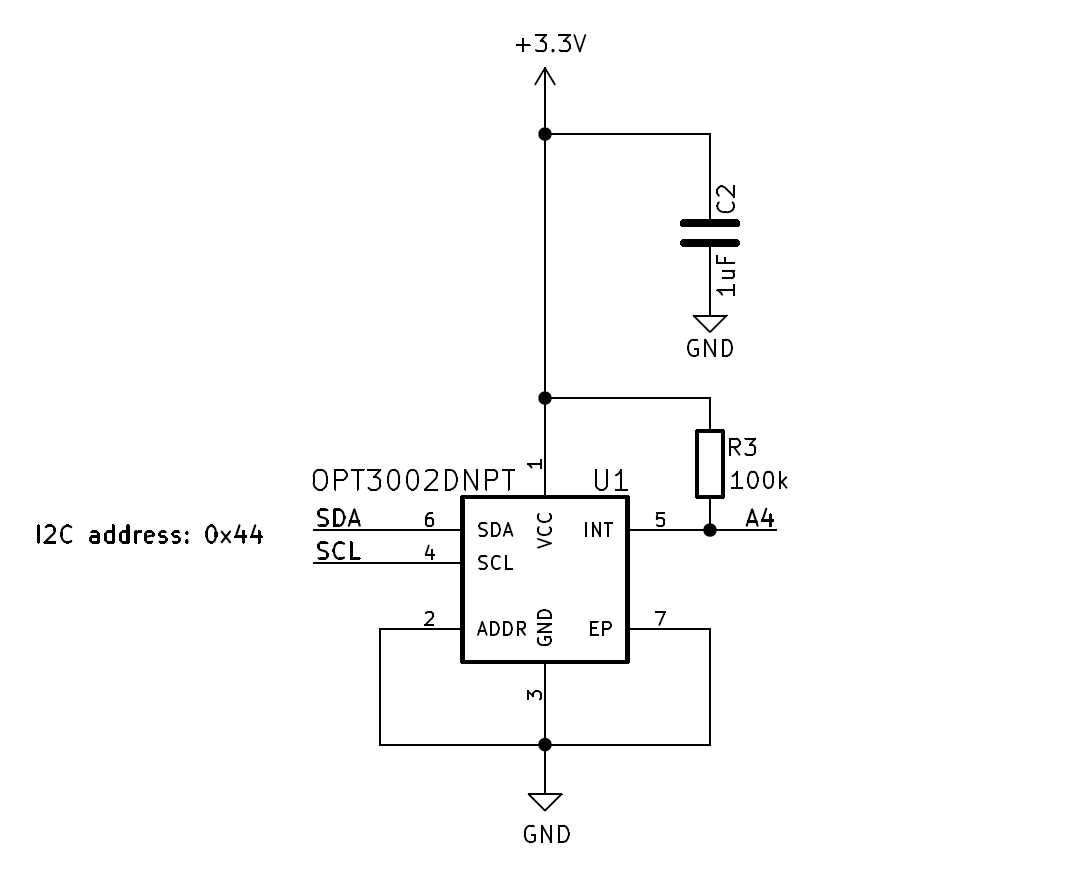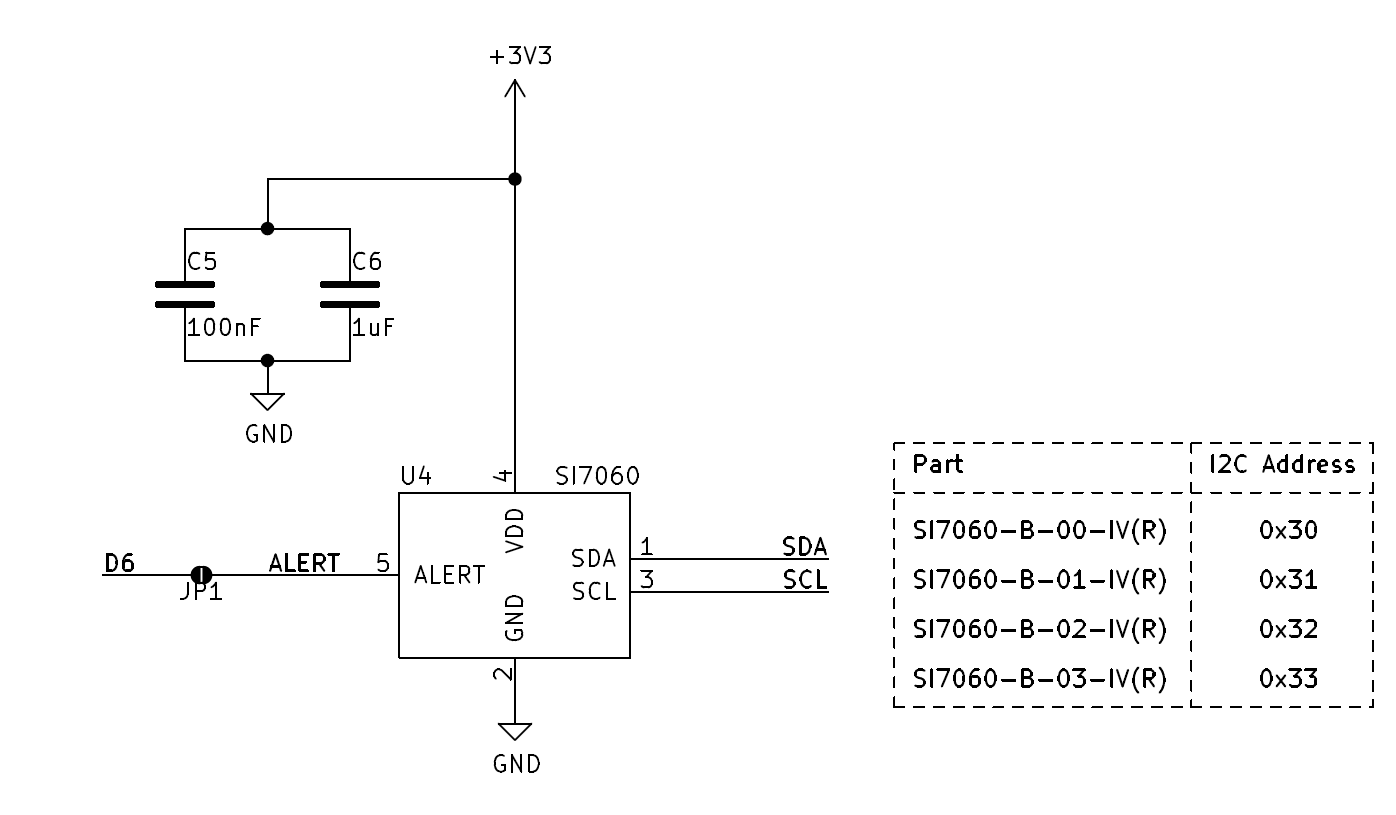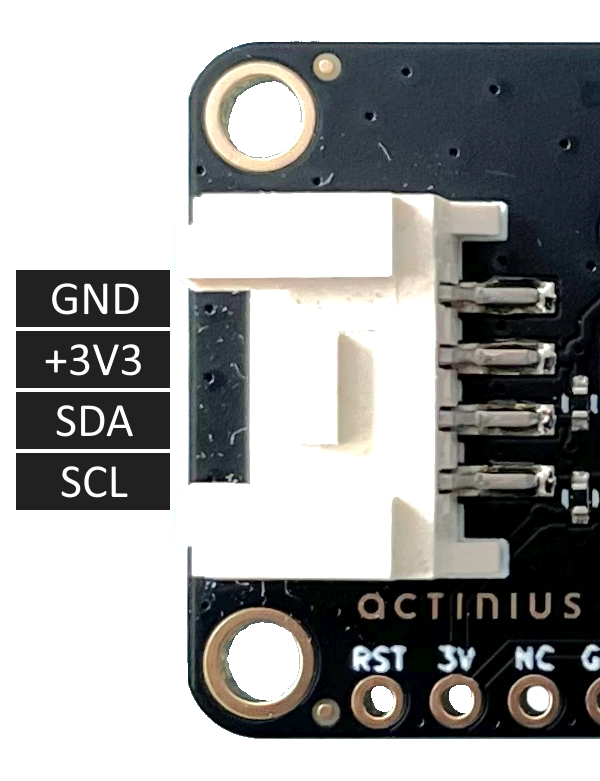Datasheet

Overview
The Actinius FeatherWing is an environmental sensing board that can measure and detect light intensity, temperature, humidity, air pressure and gas mixtures. All of the on-board sensors are accessed through the I2C-bus, which is available through the pin headers and a Grove connector. Note that the board has 4.7 kOhms pull-up resistors on the I2C lines so external pull-ups are not necessary. The FeatherWing also has datalogging capabilities through a micro SD-card connector and the SPI.
Sensors and features
- BME688 Gas sensor
- Second BME688 Gas sensor (optional)
- OPT3002 Ambient light sensor
- SI7060 Temperature sensor
- Micro SD-card connector
- Grove connector for I2C
- 4.7 kOhms pull-ups on the I2C-bus
BME688 Gas sensors
The BME688 sensor on the FeatherWing can measure several environmental parameters and cointains an AI-core that can be trained to detect certain gas compositions. The BME688 can measure the following:
- Temperature
- Humidity
- Pressure
- Gases:
- Gas resistance
- Volatile Organic Compounds (VOCs)
- Breath VOCs (b-VOCs)
- Volatile Sulfur Compounds (VSCs)
- Index for Air Quality (IAQ)
- Carbon dioxide - CO2
- Carbon monoxide - CO
- Hydrogen Sulfide - H2S
- Ethanol alcohol - EtOH
- Various gas mixtures
More information about the capabilities of the BME688 sensor can be found in the BME688 datasheet.
Each FeatherWing comes with one BME688, and an optional second BME688 which can be used to detect more gas mixtures. The I2C address of the primary BME688_1 is 0x76. The second optional sensor BME688_2 has an I2C address of 0x77.
Bosch provides the BME AI-Studio tool which allows developers to train the BME688 to detect certain gas mixtures and smells. More information can be found on the BME688 software page. An example of a use case that is given by Bosch is the detection of coffee beans. Other usecases could be: fire detection, spoiled food detection or bad breath detection.
Temperature sensor specification:
| Parameter | Min | Typ | Max | Unit |
|---|---|---|---|---|
| Operating temperature range | -40 | 25 | 85 | C |
| Supply current (1 Hz forced mode) | 1.0 | uA | ||
| Absolute accuracy at 25 C | 0.5 | C | ||
| Absolute accurace at 0-65 C | 1.0 | C | ||
| Output resolution | 0.01 | C | ||
| RMS noise | 0.005 | C |
Humidity sensor specification:
| Parameter | Min | Typ | Max | Unit |
|---|---|---|---|---|
| Operating range | -40 | 25 | 85 | C |
| 0 | 100 | % RH | ||
| Full accuracy range | 0 | 65 | C | |
| 10 | 90 | % RH | ||
| Supply current (1 Hz forced mode) | 1.1 | 1.8 | uA | |
| Absolute accuracy at 25 C | 3.0 | % RH | ||
| Absolute accurace at 0-65 C | 1.0 | C | ||
| Output resolution | 0.008 | C | ||
| RMS noise | 0.01 | % RH | ||
| Long term stability | 0.5 | % RH / year |
Pressure sensor specification:
| Parameter | Min | Typ | Max | Unit |
|---|---|---|---|---|
| Operating temperature range | -40 | 25 | 85 | C |
| Full accuracy temperature range | 0 | 65 | C | |
| Operating pressure range (full accuracy) | 300 | 1100 | hPa | |
| Supply current (1 Hz forced mode) | 1.1 | 2.2 | uA | |
| Absolute accuracy pressure (300-1100 hPa) | 0.6 | hPa | ||
| Relative accuracy pressure (700-1100 hPa) | 0.12 | hPa | ||
| Output resolution | 0.18 | Pa | ||
| RMS noise | 1.4 | Pa | ||
| Long term stability | 1.0 | Pa / year |
Gas sensor specification:
| Parameter | Min | Typ | Max | Unit |
|---|---|---|---|---|
| Operating range | -40 | 25 | 85 | C |
| 10 | 95 | % RH | ||
| Supply current during heater operation | 9 | 12 | 13 | mA |
| Peak supply current | 15 | 17 | 18 | mA |
| Average supply current (ultra-low power mode) | 0.09 | mA | ||
| Average supply current (low power mode) | 0.9 | mA | ||
| Average supply current (continuous mode) | 12 | mA | ||
| Resolution of gas sensor resistance | 0.05 | 0.08 | 0.11 | % |
| RMS noise in gas sensor resistance | 1.5 | % | ||
| IAQ resolution | 1 | |||
| IAQ range | 0 | 500 |
BME688 schematics:

OPT3002 Ambient light sensor
The OPT3002 is a ambient light-to-digital sensor that can measure light intensity in the 300 nm to 1000 nm range. The sensor is pre-callibrated and its values are compensated for dark-current effects and temperature variations. Furthermore, the sensor features a automatic range selection mode. This mode automatically selects the optical range setting for the detected lighting condition. This eliminates the requirement of programming measurement and reajustments cycles of the full-scale range. The OPT3002 also reduces noise from 50 Hz and 60 Hz light sources by integrating its results over either 100 ms or 800 ms.
The sensor comes with a INT interrupt pin that is accessible through pin A4 on the FeatherWing. The interrupt events are controlled by the high-limit and low-limit registers of the OPT3002. See the OPT3002 datasheet for more information on the interrupt capabilities of the sensor.
The I2C address of the OPT3002 is 0x44.
OPT3002 specification
| Parameter | Min | Typ | Max | Unit |
|---|---|---|---|---|
| Operating temperature range | -40 | 25 | 85 | C |
| Optical range | 300 | 1000 | nm | |
| Peak irradiance spectral responsivity | 505 | nm | ||
| Resolution (LSB) at 505 nm | 0.008196 | lux | ||
| Full-scale illuminance at 505 nm | 72671.2 | lux | ||
| Relative accuracy between gain ranges | 0.2 | % | ||
| Half-power angle (50% of full-power reading) | 60 | Degrees | ||
| Quiescent current in active mode | 1.8 | 3.7 | uA | |
| Quiescent current in shutdown mode | 0.3 | 60 | 0.47 | uA |
OPT3002 schematics:

SI7060 Temperature sensor
The SI7060 is a simple low-power temperature sensor. It can be used to increase the accuracy of the BME688 temperature sensor by comparing it's measurement results with those of the SI7060.
The SI7060 comes in 4 variants with different I2C addresses. The sensor FeatherWing comes with the SI7060-B-02-IV(R) which has the following I2C address: 0x32. More information about the sensor can be found in the SI7060 datasheet.
SI7060 specification:
| Parameter | Min | Typ | Max | Unit |
|---|---|---|---|---|
| Operating temperature range | -40 | 25 | 125 | C |
| Temperature measurement accuracy (0 to 70 C) | 0.5 | 1.0 | C | |
| Temperature measurement accuracy (-40 to 125 C) | 2.0 | C | ||
| RMS noise | 0.05 | C | ||
| Current consumption (sleep timer + 200 ms sample rate) | 0.5 | 1.5 | uA | |
| Current consumption (sleep mode at 25 C) | 0.05 | uA | ||
| Current consumption (sleep mode at 125 C) | 1.0 | uA | ||
| Current consumption (During conversion / active mode) | 600 | 800 | uA | |
| Conversion time | 143 | 160 | us | |
| Sleep time | 160 | 200 | 240 | us |
SI7060 schematics:
The SI7060 has an ALERT pin that can be programmed to trigger when a certain temperature is measured by the sensor. The ALERT signal is accessible through pin D6 on the FeatherWing after soldering the open jumper connection on the board (marked with ALERT).

Micro SD-card connector
The Micro SD-card connector can be used for datalogging and saving the values measured by the sensors on the board. The SD-card can be accessed through the SPI-bus. The pins of the SPI bus are labeled on the FeatherWing board. The chip select pin of the SD-card is connected to pin A5 on the FeatherWing.
Grove connector
The environmental FeatherWing board provides an I2C grove connector to easily connect to a microcontroller or other sensor without having to solder wires. The Grove connector has the following pinout:
